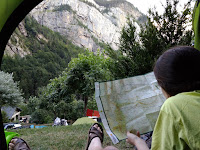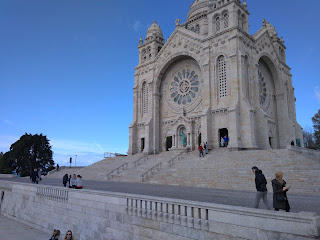For the second part of Entroido/Carnival, we crossed the border back into Galicia. In the south of the province of Ourense, Carnival is alive and kickin'. The main sites are Xinzo de Limia, Verín, and Laza.
 |
| Little Pantallas |
Our first stop was Xinzo de Limia. Despite it being a Sunday night, there were tons of people, 95% dressed in costume. Each town has their own Carnival characters, and in Xinzo they're called
Pantallas, and so far are one of my favorites. Unlike the
Peliqueiras of Laza, the
Pantallas don't hit. They simply jingle-jangle down the street and every once in a while SLAM the two blown-up, hard cow's bladders that they carry. Usually they do this to people who aren't wearing a costume, but you can also hear SLAM SLAM regardless. And in Xinzo they start 'em young; there were at least a dozen mini-
Pantallas running around town.

We turned in early for the night in Baños de Molgas, a quiet riverside village just far enough from the wild Carnival festivities to get some shut eye. The village has a spa, with the river washing up to it's door. Kind of like Venice, except I doubt anyone shows up by boat. Next to the spa is a natural hot spring, carved into a...washing station? A bath? I'm not sure which, and we didn't get in. The change in temperature made the area steamy though!

Next stop: Laza, home to some pretty wacky Carnival traditions. I had been to
Laza before, except last time we arrived after the mudslinging, and only saw the destruction left behind. This year, however, we came prepared and ready to get messy. Both of us wore work clothes and arrived when the all-out mud fest was already underway. The tiny village's main plaza was divided into two ¨sides,¨ the common enemy apparently being cleanliness. An old bathtub was filled with mud and old rags. The tradition consists of throwing muddy rags, picking some off the ground, and repeating the cycle, until your hands go numb. As we approached, there were two who I deem the ¨Clean Police,¨ because they seemed to be targeting all the newcomers. ¨Take off your glasses!¨ Splash! A muddy rag rubbed in my face! Well, at least they let me take off my glasses. I kept them in the bar. But of course, then I couldn't see to aim very well (which made hitting people that much more rewarding). I'm also grateful I didn't suffer the same fate as other ¨clean¨ people who were thrown kicking and screaming into the mud bathtub. In total, they were out there mudslinging for over 90 minutes. We sought shelter halfway through though. Mid February--that mud was cold!


In between messy Carnival traditions, we checked into our hotel which was actually a Medieval castle. In fact, I had been to visit it with friends three years ago when it was just an old castle to explore. Perfect place for a photo shoot of our Robin Hood and Maid Marian costumes! From the wraparound balcony, you could see the village of Verín below (including concerts at night), and miles of the rest of the valley. And with a welcome bottle of cava, we really did feel like royalty. That is, like count and countess.
Back in Laza for the evening, another strange tradition was about to begin. In the same main plaza from before people were starting to gather. But we went to join the festa in a ¨suburb¨ of the village, which is where the procession of ants and flour started. Yes, ants and flour. A small brass band got people psyched, as they brought out a giant ant figure. After a while, everyone walked back to the plaza, and that's where the real ants and flour started flying. By this time the plaza was absolutely packed, and we just ducked to the side of the road where people were already waiting. A few townspeople carried big sacks of dirt and ants, flinging them in the air. At one point, I wondered, 'Why are we subjecting ourselves to this? The mud can be fun, but ants!?' During the ant tossing, was flour shooting. They had what looked like leaf blowers, but loaded with flour. It's snowing! Kind of.
 |
| Blizzard? |
 |
| Follow the ant lord! |
This concludes Carnival 2018. Galicia is one of the few autonomous communities where schools have a 5-day-weekend. But there are so many curious Carnival traditions within Galicia, it'll take years to discover them all. Wonder where I'll celebrate them next year...
 Friday night, several knights ride into town on horses, to read the proclamation. That the next day commences Feira Franca! Saturday is full of activities for the whole family: an obstacle course and theatrical performance for kids; Medieval stands to peruse; jousting tournaments; Medieval dance class; spectacles and roving bands. Once again we rented a table in the old town for lunch and to rest our weary feet throughout the day. Some restaurants go all out for their lunch guests on the terrazas. It's fun to see decked out banquets, fit for the Medieval nobility seated at them. Groups of friends can also set up their own Medieval lunch under tents in the tree-lined promenade of the city center.
Friday night, several knights ride into town on horses, to read the proclamation. That the next day commences Feira Franca! Saturday is full of activities for the whole family: an obstacle course and theatrical performance for kids; Medieval stands to peruse; jousting tournaments; Medieval dance class; spectacles and roving bands. Once again we rented a table in the old town for lunch and to rest our weary feet throughout the day. Some restaurants go all out for their lunch guests on the terrazas. It's fun to see decked out banquets, fit for the Medieval nobility seated at them. Groups of friends can also set up their own Medieval lunch under tents in the tree-lined promenade of the city center.














































